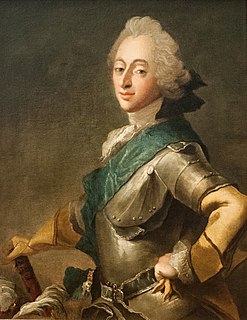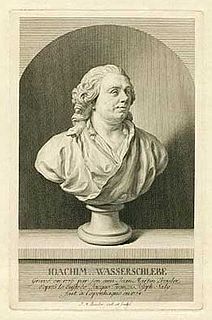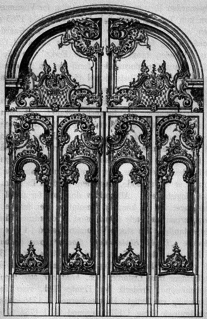
Louis August le Clerc, also known as Louis-Augustin le Clerc, was a French-born sculptor working in Denmark. He was born in Metz, France to copperplate engraver Sebastian le Clerc and his wife Charlotte van den Kerckhove. He was summoned to Denmark at the age of 47, and lived out the rest of his life there as a royal sculptor to the Danish Court and as professor at the Royal Danish Academy of Art. He helped introduce French Rococo artistic ideals to Denmark.

Jacques François Joseph Saly, also known as Jacques Saly, French-born sculptor who worked in France, Denmark, Italy and Malta, was born in Valenciennes to François Marie Saly and his wife Marie Michelle.

Nicolai Eigtved, also known as Niels Eigtved, was a Danish architect, introduced and was the leading proponent of the French rococo style in Danish architecture during the 1730s–1740s. He designed and built some of the most prominent buildings of his time, a number of which still stand to this day. He also played an important role in the establishment of the Royal Danish Academy of Art, and was its first native-born leader.

Nicolas-Henri Jardin, neoclassical architect, was born in St. Germain des Noyers, Dept. Seine-et-Marne, France, and worked seventeen years in Denmark as an architect to the royal court. He introduced neoclassicism to Denmark.

Kongens Nytorv is a public square in Copenhagen, Denmark, centrally located at the end of the pedestrian street Strøget. The largest square of the city, it was laid out by Christian V in 1670 in connection with a major extension of the fortified city, and has an equestrian statue of him at its centre. The initiative moved the centre of the city from the medieval area around Gammeltorv, at that time a muddy medieval marketplace, to a cobbled new square with a garden complex, inspired by the Royal city planning seen in Paris from the early 17th century.

Frederiksstaden is a district in Copenhagen, Denmark. Constructed during the reign of Frederick V in the second half of the 18th century, it is considered to be one of the most important rococo complexes in Europe and was included in the 2006 Danish Culture Canon.
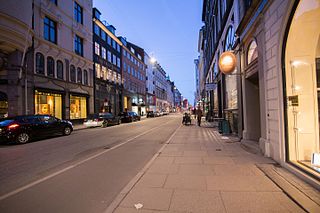
Bredgade is one of the most prominent streets in Copenhagen, Denmark. Running in a straight line from Kongens Nytorv for just under one kilometre to the intersection of Esplanaden and Grønningen, it is one of the major streets in Frederiksstaden, a Rococo district laid out in the middle of the 18th century to commemorate the tercentenary of the House of Oldenburg's accession to the Danish throne. It is lined with a number of fine mansions as well as other historic buildings. Many law firms, trade unions, fashion stores and art galleries are based in the street.

The Moltke's Mansion is a town mansion on the corner of Bredgade and Dronningens Tværgade in Copenhagen, Denmark. It is one of several town mansions in Frederiksstaden, although it actually predates the neighbourhood by half a century. It was built for Ulrik Frederik Gyldenløve between 1700 and 1702 and was originally known as Gyldenløve's Little Mansion. It received its current name in 1842, after it was acquired by Adam Wilhelm Moltke, the first Danish Prime Minister under the Danish constitutional monarchy.

¨Johan Christoph Petzold was a German sculptor who mainly worked in Denmark. He was a professor at the Royal Danish Academy of Fine Arts from its establishment in 1754 and briefly held the post of Sculptor to the Danish Court.

Carl Marcus Tuscher was a German-born Danish polymath: portrait painter, printmaker, architect, and decorator of the Baroque period.

The equestrian statue of Frederick VII in front of Christiansborg on Slotsholmen in Copenhagen, Denmark, was modelled by Herman Wilhelm Bissen and completed posthumously by his son Vilhelm Bissen in 1873. It was created to commemorate King Frederick's central role in Denmark's transition from absolute to constitutional monarchy.
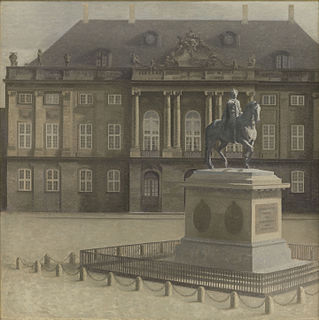
Amalienborg Square, Copenhagen is an 1896 oil on canvas painting by the Danish artist Vilhelm Hammershøi in the Statens Museum for Kunst.

The equestrian statue of Christian V, located in the centre of Kongens Nytorv, is the oldest of five equestrian statues of Danish monarchs in Copenhagen, Denmark. The equestrian statue was created by the French sculptor Abraham-César Lamoureux. Dating from 1688, it was originally made in gilded lead but recast in bronze in 1939.

Amaliegade 15–17 are two originally symmetrical, Rococo-style townhouses located close to Amalienborg Palace in the Frederiksstaden district of central Copenhagen, Denmark. The exterior of the buildings was designed by the architect Nicolai Eigtved who had also created the overall masterplan for the neighbourhood. The houses at No. 15 was heightened with a half floor in 1891.




